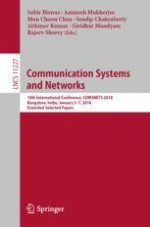2019 | Book
Communication Systems and Networks
10th International Conference, COMSNETS 2018, Bangalore, India, January 3-7, 2018, Extended Selected Papers
Editors: Subir Biswas, Animesh Mukherjee, Mun Choon Chan, Sandip Chakraborty, Abhinav Kumar, Giridhar Mandyam, Rajeev Shorey
Publisher: Springer International Publishing
Book Series : Lecture Notes in Computer Science
